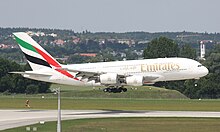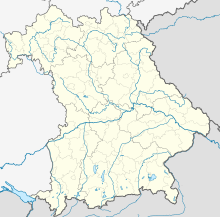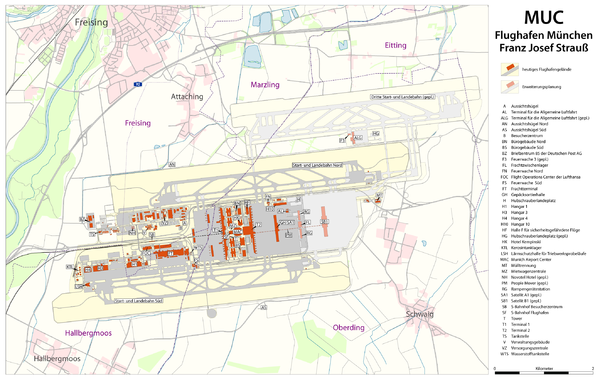Munich Airport: Difference between revisions
No edit summary |
|||
| Line 444: | Line 444: | ||
[[Munich Transport and Tariff Association|MVV]] bus lines connect the airport to the nearby city of [[Freising]] as well as [[Erding]] and [[Markt Schwaben]]. |
[[Munich Transport and Tariff Association|MVV]] bus lines connect the airport to the nearby city of [[Freising]] as well as [[Erding]] and [[Markt Schwaben]]. |
||
Lufthansa Airport Bus provides an alternative to the S-Bahn, stopping at [[Nordfriedhof (Munich U-Bahn)|''Nordfriedhof'' |
Lufthansa Airport Bus provides an alternative to the S-Bahn, stopping at [[Nordfriedhof (Munich U-Bahn)|''Nordfriedhof'' U-Bahn station]] and Munich Central Station. |
||
===Road=== |
===Road=== |
||
Revision as of 19:04, 9 February 2013
You can help expand this article with text translated from the corresponding article in German. (August 2011) Click [show] for important translation instructions.
|
Munich Airport Flughafen München | |||||||||||||||
|---|---|---|---|---|---|---|---|---|---|---|---|---|---|---|---|
 | |||||||||||||||
 | |||||||||||||||
| Summary | |||||||||||||||
| Airport type | Public | ||||||||||||||
| Owner/Operator | Flughafen München GmbH | ||||||||||||||
| Serves | Munich, Germany | ||||||||||||||
| Location | near Freising | ||||||||||||||
| Hub for | |||||||||||||||
| Elevation AMSL | 1,487 ft / 453 m | ||||||||||||||
| Website | www.munich-airport.de | ||||||||||||||
| Map | |||||||||||||||
| Runways | |||||||||||||||
| |||||||||||||||
| Helipads | |||||||||||||||
| |||||||||||||||
| Statistics (2012) | |||||||||||||||
| |||||||||||||||

Munich Airport (IATA: MUC, ICAO: EDDM) (German: Flughafen München), is an international airport located 28.5 km (17.7 mi) northeast[2] of Munich, Germany, and is a hub for Lufthansa and Star Alliance partner airlines. It is located near the old city of Freising and is named in memory of the former Bavarian Prime minister Franz Josef Strauss. The airport is located on the territory of four different municipalities: Oberding (location of the terminals; district of Erding), Hallbergmoos, Freising and Marzling (district of Freising).
Between 1995 and 2006, passenger numbers doubled from under 15 million per annum to over 30 million,[3] despite the impact of the September 11 attacks in 2001 and 2002. In 1996, the airport overtook Düsseldorf as Germany’s second busiest airport and currently handles almost twice as many passengers as the country’s third busiest airport. However (once the new airport opens), Berlin is expected to catch up.[citation needed] Munich Airport serves as Lufthansa’s second hub in Germany besides Frankfurt.
Munich Airport is the second busiest airport in Germany in terms of passenger traffic behind Frankfurt Airport, and the seventh busiest airport in Europe, handling 38,360,604 passengers in 2012.[1] It is the world's 12th busiest airport in terms of international passenger traffic,[4] and was the 27th busiest airport in the world in 2011.
History
From 1939 to 1992, Munich was served by Munich-Riem airport. First plans to expand or build a new airport were made in 1954 (traffic flow-rate, population density in the proximity). The decision for building the new airport at Erdinger Moos was done on 5 August 1969 by the Bavarian government. When construction started on 3 November 1980, a village named Franzheim was demolished and their ~500 inhabitants were resettled.
The airport commenced operation on 17 May 1992, when operations moved from the former site at Munich-Riem, which was closed shortly before midnight on the day before. As Lufthansa's home base at Frankfurt Airport had capacity limits, Lufthansa established a second hub offering connections through Munich as well as Frankfurt.
In June 2003, Terminal 2 was finished, housing Star Alliance partners exclusively.
Due to the rapid increase in traffic Munich is currently slot constrained and a third runway is now being planned. Not uncommon for such a project, there is considerable opposition from the nearby residents. Lawsuits against the runway have already been announced.
The airport is named after Franz Josef Strauß, who played a prominent, albeit sometimes controversial role in politics of the Federal Republic of Germany from the 1950s until his death in 1988. Among other positions, Strauß was a long-time Minister-President (Governor) of the state of Bavaria, where the airport is located and was initiated under his government. Strauß, having been a private pilot himself, had a particular interest in the aviation industry. He is regarded one of the fathers of Airbus and served as initial chairman of its supervisory board.[5]
Naming the airport by its full name "Flughafen München Franz Josef Strauß" is quite uncommon. The company that owns and operates the airport is named "Flughafen München GmbH" and brands itself as "M - Flughafen München" respectively "M - Munich Airport". In the Munich area, most people use the term "Flughafen München" (Munich Airport), sometimes "Flughafen München II" in order to distinguish from the earlier airport or simply "MUC" for its IATA-code.
Terminals and facilities
Most of the airport's facilities are located in the area between the two runways. The approach road and railway divide the west part into a southern half, which contains cargo and maintenance facilities, and a northern half, which contains mostly administrative buildings, a holiday long-term parking lot and the Visitors' Centre. It is followed by the west apron and Terminal 1, then the Munich Airport Center (MAC), Terminal 2 and the east apron.
Terminal 1

Terminal 1 is the older terminal and commenced operation when the airport was opened on 17 May 1992. It has a total capacity of 25 m passengers per annum and is subdivided into five Modules designated with capital letters A, B, C, D and E. Modules A through D provide all facilities necessary to handle departures and arrivals, including landside drive-by lanes and parking, whereas module E is only equipped to handle arrivals. This design essentially makes each module a self-contained sub-terminal of its own, which is small and comfortable despite the total size of the terminal. Hall F is separate, located near Terminal 2 and handles flights with increased security requirements, i.e. those to Israel. Further, checkin for some flights departing from Terminal 1 is located in the Central Area Z (German: Zentralbereich).
The 1,081 m (3,547 ft) pier features 21 jet bridges, two of which have been rebuilt into waiting halls for bus transfers. There are further 60 waiting positions on the apron, some of which are equipped with specially-designed apron jet bridges (German: Vorfeldfluggastbrücken), to which passengers are brought by bus. This unique concept allows passengers to board with full protection from the weather but without the high investments required for full satellite terminals connected through a passenger transport system.
Terminal 1 currently handles all flights from airlines that are not members of Star Alliance. However, due to lack of capacity at Terminal 2, Lufthansa subsidiary Germanwings and affiliate Condor moved back to Terminal 1. Further, Hall F handles flights to Israel from all airlines.
Terminal 2

Terminal 2 commenced operation on 29 June 2003. It has a design capacity of 25 million passengers per year. However, having been designed as a hub terminal for Lufthansa and Star Alliance members, it is not divided into modules. Instead, all facilities are arranged around a central Plaza.
Due to security regulations imposed by the European Union, the terminal has been equipped with facilities to handle passengers from countries considered insecure, i.e. not implementing the same regulations. This required the construction of a new level as, unlike other airports, the terminal does not have separate areas for arriving and departing passengers. The new level 06 opened on January 15, 2009.
The pier, which is 980 m (3,220 ft) long, is equipped with 24 jet bridges. As the total number of waiting positions of 75 on the East Apron is not always sufficient, Terminal 2 sometimes also uses waiting positions on the West Apron, to which passengers are carried by airside buses.
Terminal 2 has two main departure level, 04 and 05 and additional Bus gates on the lower level 03. Gates on level 05 (H) are designated Non-Schengen Gates. Until the new level 06 opened the northernmost gates were behind an additional security checkpoint for departures to the USA most of the day. The lower level 04 (G) contains Schengen gates. The bus gates on level 03, also designated G, are Schengen gates, too.
The terminal is operated by Terminal-2-Betriebsgesellschaft (German for Terminal 2 Operating Company), which is owned by Flughafen München GmbH (60%) and Lufthansa (40%). This makes Terminal 2 the first terminal in Germany which is co-operated by an airline.
There is a baggage sorting hall on the apron, which is planned to be extended into a satellite terminal for Terminal 2.
Runways
The Franz-Josef Strauss Airport has two parallel runways and one helipad. The two runways at Munich’s airport are 08R/26L and 26R/08L, made of concrete and the same size, at 4,000 metres (13,120 ft) long, and 60 metres (200 ft) wide.[6] There is also a concrete helipad that is 98 feet across.[citation needed]
Munich Airport Centre (MAC)

The Munich Airport Centre (MAC) is a shopping, business and recreation area that connects the two terminals. The older Central Area (German: Zentralbereich), which was originally built as part of Terminal 1, hosts a shopping mall and the S-Bahn station. The newer MAC Forum built with Terminal 2 is a large outdoor area with a tent-like, partly transparent roof. Next to it is the airport hotel managed by Kempinski.
Visitor viewing facilities
The airport authorities have set out to cater for visitors and sight-seers by creating a 'Visitors Park' which includes a 'Visitors Hill' from which a good view can be obtained of the westerly aircraft apron and Terminal 1. This is served by a railway station named 'Besucherpark'. The view from the hill is shown in the above image. There are three historic aircraft on display in the park, a Super Constellation, a Douglas DC-3 and a Junkers Ju 52/3m. There is also a visitors viewing terrace on the roof of Terminal 2 that gives a view of the easterly aircraft apron.
Airlines and destinations
This section needs additional citations for verification. (December 2012) |




















Passenger
Cargo
Statistics
| Rank | City | Passengers | Top Carriers |
|---|---|---|---|
| 1 | 1,084,000 | British Airways, Lufthansa | |
| 2 | 970,000 | Air France, Augsburg Airways, Lufthansa, Lufthansa CityLine, Régional | |
| 3 | 673,000 | KLM, KLM Cityhopper, Lufthansa CityLine | |
| 4 | 672,000 | Air Nostrum, Augsburg Airways, Iberia, Lufthansa | |
| 6 | 646,000 | Lufthansa, Vueling | |
| 7 | 548,000 | Lufthansa, Turkish Airlines | |
| 8 | 543,000 | Air Berlin, Condor, Lufthansa, TUIfly | |
| 9 | 536,000 | Austrian Airlines, Lufthansa, Lufthansa CityLine, Niki, Tyrolean Airways, TUIfly | |
| 10 | 520,000 | Emirates, Lufthansa | |
| 11 | 511,000 | Air Dolomiti, Air One, Alitalia, Lufthansa, Lufthansa CityLine | |
| 12 | 481,000 | Air Berlin, Atlasjet, Condor, Lufthansa, Sky Airlines, Sun Express, SunExpress Deutschland, Tailwind Airlines, TUIfly | |
| 13 | 364,000 | Air Dolomiti, Lufthansa | |
| 14 | 328,000 | Lufthansa, United Airlines | |
| 15 | 306,000 | Lufthansa, United Airlines | |
| 16 | 264,000 | ANA, Lufthansa |
Other facilities
DBA, originally Deutsche BA, had its head office on the grounds of Munich Airport and in Hallbergmoos.[13][14]
Access
Railway
Munich Airport S-Bahn service | |||||||||||||||||||||||||||||||||||||||||||||||||||||||||||||||||||||||||||||||||||||||||||||||||||||||||||||||||||||||||||||||||||||
|---|---|---|---|---|---|---|---|---|---|---|---|---|---|---|---|---|---|---|---|---|---|---|---|---|---|---|---|---|---|---|---|---|---|---|---|---|---|---|---|---|---|---|---|---|---|---|---|---|---|---|---|---|---|---|---|---|---|---|---|---|---|---|---|---|---|---|---|---|---|---|---|---|---|---|---|---|---|---|---|---|---|---|---|---|---|---|---|---|---|---|---|---|---|---|---|---|---|---|---|---|---|---|---|---|---|---|---|---|---|---|---|---|---|---|---|---|---|---|---|---|---|---|---|---|---|---|---|---|---|---|---|---|---|
| |||||||||||||||||||||||||||||||||||||||||||||||||||||||||||||||||||||||||||||||||||||||||||||||||||||||||||||||||||||||||||||||||||||
Munich Airport is connected to the city by Munich suburban railway lines S1 and S8. The ride takes approximately 45 minutes to the Marienplatz station in the city centre. Furthermore, a scheduled bus service (MVV line 635) connects the airport within 20 minutes to the Freising railway station, providing access to regional trains to destinations like Munich, Nuremberg, Regensburg and Prague.
Munich Airport Station is located in a tunnel beneath the central area. A second station, Besucherpark (German: Visitors' Park) connects the cargo and maintenance areas, long-term parking, administrative buildings and the name-giving Visitors' Park.
A second tunnel beneath the terminals is currently unused. Originally, there were plans to use it for intercity railway, then for a Transrapid maglev train making the trip to Munich Central Station in 10 minutes. However, this project was cancelled in March 2008 due to cost escalation.[15]
Bus
MVV bus lines connect the airport to the nearby city of Freising as well as Erding and Markt Schwaben.
Lufthansa Airport Bus provides an alternative to the S-Bahn, stopping at Nordfriedhof U-Bahn station and Munich Central Station.
Road

Munich Airport is accessible via nearby Motorway A 92, which connects to Motorway A 9 and Munich's ring motorway A 99
Bavarian State Road St. 2584 connects A 92's exit 6 (Flughafen München) - an incomplete interchange that can only be used by traffic to and from the west - to the terminals. Access from the east is possible via exit 8 (Freising Ost) and Bavarian State Road St. 2580, which connects to St. 2584 in the east of the airport.
Expansion Plans
Third runway
A third runway would increase the number schedulable aircraft movements per hour from 90 to 120.[16] It would run in parallel to the existing runways and be located to the northeast of the current north runway, significantly extending the total area occupied by the airport.
According to Flughafen München GmbH (FMG), the airport's operator, the current two-runway system is already operating at full capacity during peak hours, and requests for additional slots from airlines have been denied. Further increase in air traffic is expected as Munich is to become a second major hub in Germany after Frankfurt.
In August 2007, the airport operator applied for a planning permission from the government of Upper Bavaria. As more than 60,000 objections have been filed during public display of the plans, the procedures are expected not to conclude before 2013.
While according to ICAO Regulations (Annex XIV) the new runway would have to be named 08L/26R (renaming the existing north runway to 08C/26C), it is currently assigned the working title 09/27 in all plans.[17]
Terminal 2 extension
An extension to Terminal 2 will see the baggage sorting hall on the east apron upgraded to become a satellite terminal. This will allow an additional 11 million passengers to be handled per year, adding 52 gates and 27 passenger air bridges. This plan was approved in December 2010. An expansion for the satellite building into a 'T' shape is also planned for the future along with another satellite and room for a possible 3rd Terminal to the east.[18]
While Terminal 1 still has plenty of capacity left - in 2007, it only handled about 9 m passengers - the extension of Terminal 2 is required by Lufthansa and its Star Alliance partners to allow easy transfers within a single terminal. When Terminal 2 and its east apron were built, preparations for a satellite terminal had already been made. Besides the baggage transport tunnel, there are three more tunnels beneath the Terminal 2 apron that can receive a people mover and extensions to the current S-Bahn rail tunnel and unused inter-city rail tunnel respectively. The preparations also allow construction of a second satellite or an independent third terminal further to the east. Construction for this satellite building has started in 2012.
References
- ^ a b ADV passenger statistics and aircraft movements
- ^ a b EAD Basic
- ^ anna.aero (20 April 2010). "Munich's traffic doubles in 10 years; Lufthansa adds more routes than it drops as a host of new airlines announce new services". anna.aero Airline News & Analysis.
- ^ Airports Council International - Year to date International Passenger Traffic Data
- ^ Company history on Airbus.com - Early days (1967-1969)
- ^ Munich Airport Facts and Figures: 2011/2012
- ^ http://airlineroute.net/2012/10/18/a3-klx-s13/
- ^ L, J (5 December 2012). "CSA Czech Airlines Adds 5 European Routes in S13". Routesonline / Routes. Retrieved 6 December 2012.
- ^ "Lufthansa launching new route from Munich to Vancouver" (Press release). Lufthansa. 26 October 2012. Retrieved 30 October 2012.
- ^ http://www.maastricht-airlines.com/
- ^ "Открыта продажа авиабилетов в Германию в аэропорты Дюссельдорф, Ганновер, Мюнхен!". Новости. Joint Stock Company "Orenburg airlines". Retrieved 13 December 2012.
- ^ http://airlineroute.net/2012/09/30/r3-de-w12/
- ^ "World Airline Directory." Flight International. 29 March-4 April 1995. 68. "Wartungsallee 13, Munchen-Flughafen, Munchen D-85 356, Germany"
- ^ "Contact Us." DBA. 4 February 2004. Retrieved on 21 January 2010. "dba Luftfahrtgesellschaft mbH Wartungsallee 13 85356 München,. Munich Airport Germany" The address on Google Maps goes to "Wartungsallee 13 85356 Hallbergmoos, Germany."
- ^ "Germany Scraps Transrapid Rail Plans". Deutsche Welle. 2008-03-27. Retrieved 2008-03-27.
- ^ MUC Airport - Facts and Figures 2010/2011 (p.10)
- ^ DC Airports (2007-08-20). "Erläuterungsbericht Technische Planung Luftseite" (PDF). Planfeststellungsverfahren 3. Start- und Landebahn (in German). pp. 16, 42. Retrieved 2008-11-24.
{{cite web}}: CS1 maint: unrecognized language (link) - ^ "Lufthansa and Munich operator approve Terminal 2 satellite". Retrieved 2011-01-02.
External links




